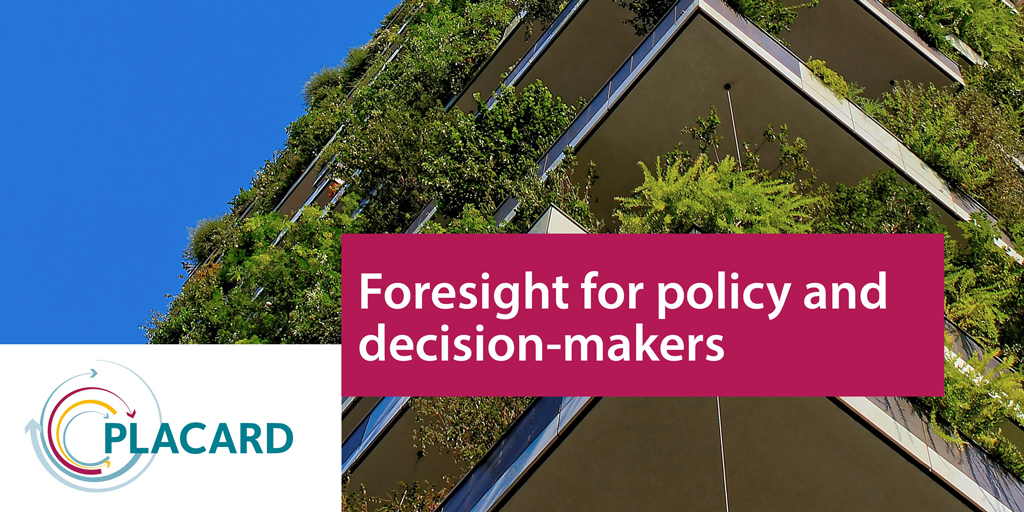Article /
Foresight for policy & decision-makers

Summary
An updated version of the PLACARD project’s Foresight for policy and decision-makers report is now available to download. The document* explores the application of foresight and foresight processes as a “multimethod” forward-looking toolkit that can be relevant for both the climate change adaptation (CCA) and disaster risk reduction (DRR) communities, as well as enhancing integration across science, policy and practice. It builds on several workshops and a webinar (video provided above) during the course of the PLACARD project.
Foresight is a systematic, participatory, future intelligence gathering and medium- to long-term vision-building process to inform present-day decisions and mobilise joint actions. This report explores the potential role of foresight in integrating DRR and CCA through an analysis of the most common foresight methods.
Foresight methods are used in both CCA and DRR, but are often limited to quantifying risks and do not explore response options. CCA and DRR efforts can be better integrated through use of a broader set of foresight methods, which will help strengthen the link between international mechanisms such as the UNFCCC Paris Agreement, the Sendai Framework and the Sustainable Development Goals (SDGs), by exploring their implications for European, national and local action.
The report also supports European CCA and DRR research programming by distilling key research needs and gaps, and explores potential connections with ongoing or planned research on foresight.
In the report
This report includes an introduction to foresight, discussion of the potential for foresight application in CCA–DRR collaboration, a review of foresight methods (including strengths and weaknesses, relevant references and further reading), discussion of the potential role of foresight methods in CCA-DRR supporting policy and decision-makers, a description of foresight exercises as a common approach useful for CCA and DRR integration, discussion of the relevance of foresight methods and application for CCA and/or DRR, a description of foresight experiences during PLACARD and other experiences and activities using foresight (including in national and EU adaptation planning), the characteristics of “effective” foresight methods in CCA and DRR policymaking, future opportunities on using foresight to enhance CCA and DRR cooperation and integration, and reflections and conclusions.
*Download the full text from the right-hand column. The key messages from the report can be found below.
How effective foresight methods can support CCA and DRR
Participants in PLACARD activities confirmed that the use of foresight methods can go beyond the current support to CCA and DRR research, policy and practice, and promote better connections and integration across the two communities. For example, foresight methods going beyond quantitative scenarios and modelling may have the potential to increase the effectiveness and relevance of futurethinking work in a joint CCA-DRR policy context. Several factors support this rationale, and suggest that effective foresight may:
- Enhance the effectiveness of participatory processes, cooperation and dialogue;
- Produce salient knowledge and capacity building that is relevant for future decisionmaking and policy support;
- Facilitate the understanding of issues and concepts such as complexity, uncertainty, nonlinearity, wildcards and surprises;
- Generate levers that build flexibility into policy measures and across policy areas;
- Address different time scales simultaneously (e.g., connect long-term CCA/prevention with short-term DRR/preparedness);
- Be used in the context of trust building and the development of shared values;
- Allow for the use of a holistic perspective in connecting different policy areas. However, and in order to successfully apply foresight methods, several challenges have to be taken into consideration, thus deserving further thought:
- Each situation is different and requires specific knowledge input: there is no single “best practice” or “scientifically proven” approach to foresight;
- Foresight is a learning process for all participating actors, making it demanding and difficult even if the stakes are well known;
- People are vital: any foresight activity should address ownership by the participants and move beyond scientific/technical considerations, as often “perception is considered as reality” for many involved in making decisions;
- Foresight activities should consider both products and processes;
- Participation should extend beyond the scientific and policy community, engaging a broad range of societal actors, including youth (it is about their future) and artists (mobilising their creativity to imagine novel risks and unconventional solutions);
- Foresight does not necessarily lead to quick, direct and easy results so expectations should be moderated;
- Foresight exercises should not adhere to a strictly controlled process but rather retain flexibility;
- Recommendations resulting from foresight exercises are not expected to be automatically implemented, and should not necessarily be seen as directly leading to priority setting.
Conclusions
Our work on foresight confirmed the hypothesis that foresight methods and their practical application can be a useful tool to support decision-making in CCA and DRR, but that its implementation in Europe can be extended and further improved.
Based on the work report findings and the outcomes of PLACARD foresight-promotion activities, the following conclusions can be drawn:
- Foresight methods can provide valuable support and a better understanding of the needs and barriers regarding the integration of the “future” dimension in current decision-making, thus leading to more long-term thinking in both CCA and DRR policy and practice;
- There is an identified need to bring the two communities (DRR and CCA) together in concrete activities with clearly defined goals, in order to test, apply and check if foresight methods are able to provide the required (salient) outputs for both policy and practice;
- Foresight activities should promote a clear understanding of the differences and similarities in perspectives and expectations across communities, including the different views CCA and DRR practitioners may have on similar situations and issues;
- Specific opportunities for connecting CCA and DRR through foresight should be sought, for example, through research programming and projects, engaging a broad set of people beyond scientists and policymakers;
- Future research should aim to improve capacity building regarding the integration of DRR and CCA, for example, by exploring issues around how CCA actors can benefit from a clearer understanding of the importance of DRR focusing on extreme climate events, while DRR communities may benefit from incorporation adaptive and long-term perspectives, when focusing on disaster prevention.
Suggested citation
Leitner, M., Bentz, J., Capela Lourenço, T., Swart, R., Coninx, I., Allenbach, K. & Rohat, G.T. 2019. Foresight report for policy- and decision-makers. PLACARD project, FC.ID: Lisbon.
